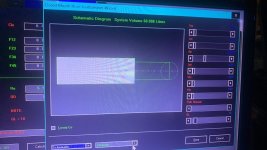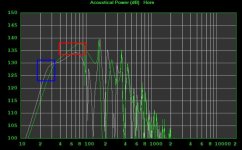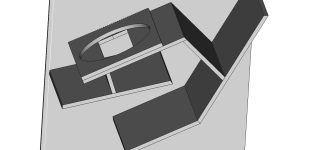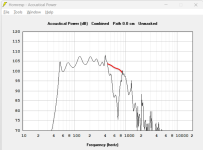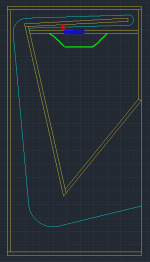Not had any experience of packing a rear chamber to that extent. But questioning the design as presented & checking for any possible anomalies or errors is worhwhile! With out the packing the response has a massive suckout - Like most scoop designs!
Absolutely! More to come as time permits.............assuming I'm following correctly, the last section is totally wrong plus technically they should all be 'par' assuming parallel sides.......
@GM The lasts section in the model shared is for a tapered final section, rather than a stepped one per my original drawing. Everything else is the same. I am confident in my ability to create a drawing that matches a simulation (or vice versa), but can provide some updated drawings if that makes critiquing the design easier.
@Xoc1 thank you! I'm leaning on the community here to help me find anything I have missed. I've packed it for exactly the reason you've mentioned.
I am still interested in what people think is a suitable upper limit for a compression ratio here. Given the high motor strength, long xmax, 4 inch voice coil and moderately high mmd, I would have thought that this woofer would be a good candidate for horn loading, however I am certainly no expert here.
@Xoc1 thank you! I'm leaning on the community here to help me find anything I have missed. I've packed it for exactly the reason you've mentioned.
I am still interested in what people think is a suitable upper limit for a compression ratio here. Given the high motor strength, long xmax, 4 inch voice coil and moderately high mmd, I would have thought that this woofer would be a good candidate for horn loading, however I am certainly no expert here.
Last edited:
Sure would be nice! At 78, useful 'life' is getting really short...............
OK, I've successfully done as much as 20:1, but it's a 'horses for courses' choice with 3:1 a common upper limit for (sub) bass and lower for BLH apps to keep delay reasonable, though DSP can alleviate the problem, but ask Tom Danley, he's done his share of testing.............
OK, I've successfully done as much as 20:1, but it's a 'horses for courses' choice with 3:1 a common upper limit for (sub) bass and lower for BLH apps to keep delay reasonable, though DSP can alleviate the problem, but ask Tom Danley, he's done his share of testing.............
OK @GM Here's a compromise with a 4:1 ratio. We aren't talking "sub bass" per se here, given this will run with a 50hz 24db/oct high pass.
I reduced the height somewhat, and still managed to get ok 60hz performance.
A scale drawing for your viewing pleasure. the rear chamber will be divided, so that it is only as narrow as the driver (not the 500mm width of the cab), and packed to reduce the volume as much as feasible



Hornresp file is also attached. I am wondering how big the nulls will be at 250hz and 400hz. I am hopeful that the bends in the horn will smooth things out a little up that high.
'
Feedback from all and sundry is much appreciated.
I reduced the height somewhat, and still managed to get ok 60hz performance.
A scale drawing for your viewing pleasure. the rear chamber will be divided, so that it is only as narrow as the driver (not the 500mm width of the cab), and packed to reduce the volume as much as feasible
Hornresp file is also attached. I am wondering how big the nulls will be at 250hz and 400hz. I am hopeful that the bends in the horn will smooth things out a little up that high.
'
Feedback from all and sundry is much appreciated.
Attachments
Hornresp file is also attached. I am wondering how big the nulls will be at 250hz and 400hz. I am hopeful that the bends in the horn will smooth things out a little up that high.
Going to different topology as suggested in the post #12 you could achieve attached results, no dips, with the same total volume but you were not interested. That could be optimized further like trying to adding front chamber, etc. All depends how wider and smooth the results needs to be and how much complex.
In order to minimize the dip in the BLH You could add damper material in the horn segment, you can simulate this effect with Loudspeaker Wizard tool inside hornresp, but the improvement will have some costs.
Thank you @LORDSANSUIGoing to different topology as suggested in the post #12 you could achieve attached results, no dips, with the same total volume but you were not interested. That could be optimized further like trying to adding front chamber, etc. All depends how wider and smooth the results needs to be and how much complex.
In order to minimize the dip in the BLH You could add damper material in the horn segment, you can simulate this effect with Loudspeaker Wizard tool inside hornresp, but the improvement will have some costs.View attachment 1220297
I am totally open to different topologies, but I could get a front loaded horn to run the 3 octaves from 50-400hz with efficiency above 97db. Perhaps I need to tinker more with some of the designs you suggested. The midrange I wanted to used isn't happy running much lower than 400hz.
@Booger weldz if I'm reading your simulation correctly, your using two of the drivers I have (I only have one) and your efficiency at 100hz is 92db. I'm looking at over 100db sensitivity with one driver. Given the application is bass guitar, high fidelity is not required, and if I have to use a healthy amount of eq to tame some peaks, that's not a huge issue in this application.
Now if you can get me 100db sensitivity with an offset TL from 50hz upwards, we're talking.
Now if you can get me 100db sensitivity with an offset TL from 50hz upwards, we're talking.
oh, nope, I think the offset driver TL/BR hybrid ideas fall short on the SPL needs …. Bummer
Maybe an offset driver expanding path qw resonator, but the cancelation notch is way down into your wanted bandwidth 😥
Maybe an offset driver expanding path qw resonator, but the cancelation notch is way down into your wanted bandwidth 😥
Now if you can get me 100db sensitivity with an offset TL from 50hz upwards, we're talking
It's not possible. Phisics
To achieve wide bandwidth as you want you need to go direct radiation models such as BR, TL, etc and be small, wide the low SPL, or you go FLH and increase size to achieve such high SPL. To achieve 50Hz with 10" driver you may need to add vent on the rear chamber otherwise the box is going to be huge.
Going higher order, you will always trade bandwidth to SPL and so it will narrow the response, High order seen very nice for subwoofer but no to midrange.
The only one exception might be the Paraflex top, you can see thread below, you need to do so many things to fix the dips in the response that I don't know if it worth the effort, at the end the size is very similar to FLH.
https://www.diyaudio.com/community/threads/hornresp-model-for-paraflex-top.403288/
OK @LORDSANSUI , you were right, and I was wrong!Going to different topology as suggested in the post #12 you could achieve attached results, no dips, with the same total volume but you were not interested. That could be optimized further like trying to adding front chamber, etc. All depends how wider and smooth the results needs to be and how much complex.
In order to minimize the dip in the BLH You could add damper material in the horn segment, you can simulate this effect with Loudspeaker Wizard tool inside hornresp, but the improvement will have some costs.View attachment 1220297
Here's another topology that achieves my goals with a much smoother delivery.
A front loaded horn with a vented rear chamber.
While the response is much smoother, it also drops like a rock below fb. Whether this creates an audible problem or not, I am not sure. The graph shown is with a HPF that will allow 500w input without exceeding xmax.
Hornresp file attached if anyone is interested in critiquing it.
Attachments
OK @LORDSANSUI , you were right, and I was wrong!
It's just sharing experience, at certain point you can see what each feature gives you.
To improve the response, avoid offset driver, you easily remove it adding one panel and a throat adapter. See attachment #1 and the result it will give you in the attachment #2 red line. Attachment #3 show you where to add it.
Check group delay, you will see that the vent improves the low end but at certain price (increased group delay).
Ice volume isn't a problem and for sure power will not be a problem playing only guitar with the box, so you can go full sealed.
HessBH layout, revoing off-set drive may offer a good layout to achieve your horn lenght, otherwise you can go the SuperBassHorn layout that need to remove the offset too.
While for Subwoofer offset isn't a problem for wide range it's and you will see the result in the simulation.
Attachments
- Home
- Loudspeakers
- Subwoofers
- How Many Folds is Too Many
